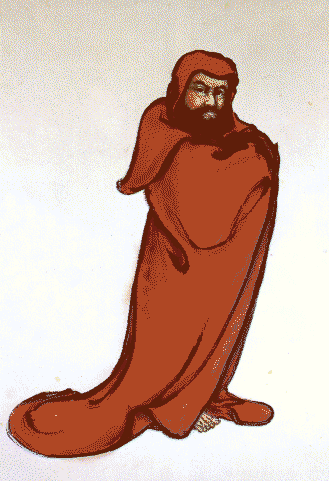|
Bodhidharma
(470 - 543)
His Holiness The 28th Patriarch of Indian Buddhism
His Holiness The First Patriarch
of Chinese Zen Lineage
What Shakyamuni expounded that day of Vulture Peak Mountain was testimony of the Mind Seal. Ananda became Mahakasyapa's heir,
and the lineage of the single transmission spread across 28 generations to the 28th Indian patriarch, Bodhidharma, who crossing
over to China became the first patriarch there.
Bodhidharma is credited with bringing Zen Buddhism to China and he
is the First Patriarch of Chinese Zen Lineage. He was born on Oct. 5th. (Chinese Lunar Calendar) in Southern India, and was
the third son of an Indian King; the royal family belonged to the Bhramin caste. Bodhidharma's Buddhist Master, Prajnatara,
was the 27th Patriarch of Indian Buddhism, taught Bodhidharma for many years, gave him Mind Transmission, made him the 28th
Patriarch, and gave him the name Bodhidharma. Following the instruction of his Master to transmit Dharma to China, Bodhidharma
traveled east to Southern China in 526 A.D. When he arrived in Kwang Chou, he was ceremoniously welcomed and greatly honored
by the local military official named Shao Yang. The same year, he was invited to the Capitol, Nanjing, to meet Emperor Wu
Di of the Liang dynasty. Because the communication between the Emperor and Bodhidharma was mutually unsatisfactory, Bodhidharma
left the palace, crossed the Yangtzu River, and continued north until he arrived at the Shao Lin Temple in Ho Nan Province.
It was here that Bodhidharma became famous for meditating 9 years facing a wall.
After he gave his disciple, Hui
K'o, the Robe, Begging Bowl, Lankavatara Sutra, and Mind Transmission, Bodhidharma went to Chen Sung (One Thousand Saints)
Temple to propagate the Dharma. He passed into Nirvana in 536 A.D., was buried in Shon Er Shan (Bear Ear Mountain) in Ho Nan,
and a stupa was built for him in Pao Lin Temple. Later, the Tang dynasty Emperor, Dai Dzong, bestowed on Bodhidharma the name
Yuen Che Grand Zen Master, and renamed his stupa as Kong Kwan (Empty Visualization).
Bodhidharma, in true Mahayana
spirit, was moved to pity when he saw the terrible physical condition of the monks of the Shaolin Temple. The monks had practiced
long-term meditation retreats, which made them spiritually strong but physically weak. He also noted that this meditation
method caused sleepiness among the monks. Likening them to the young Shakyamuni, who almost died from practicing asceticism,
he informed the monks that he would teach their bodies and their minds the Buddha's dharma through a two-part program of meditation
and physical training.
Bodhidharma created an exercise program for the monks which involved physical techniques
that were efficient, strengthened the body, and eventually, could be used practically in self-defense. When Bodhidharma instituted
these practices, his primary concern was to make the monks physically strong enough to withstand both their isolated lifestyle
and the deceptively demanding training that meditation requires. It turned out that the techniques served a dual purpose as
a very efficient fighting system, which evolved into a marital arts style called Gung Fu. Martial arts training helped the
monks to defend themselves against invading warlords and bandits. Bodhidharma taught that martial arts should be used for
self-defense, and never to hurt or injure needlessly. In fact, it is one of the oldest Shaolin axioms that "one who engages
in combat has already lost the battle."
Bodhidharma, a member of the Indian Kshatriya warrior class and a master
of staff fighting, developed a system of 18 dynamic tension exercises. These movements found their way into print in 550 A.D.
as the Yi Gin Ching, or Changing Muscle/Tendon Classic. We know this system today as the Lohan (Priest-Scholar) 18 Hand Movements,
the basis of Chinese Temple Boxing and the Shaolin Arts.
Some historians dispute the date, but legend states that
Bodhidharma settled in the Shaolin Temple of Songshan in Hunan Province in 526 A.D. We do know the first Shaolin Temple of
Songshan was built in 377 A.D. for Pan Jaco, "The First Buddha", by the order of Emperor Wei on the Shao Shik Peak
of Sonn Mountain in Teng Fon Hsien, Hunan Province. The Temple was for religious training and meditation only. Martial arts
training did not begin until the arrival of Bodhidharma in 526 A.D. Bodhidharma died in 539 A.D. at the Shaolin Temple at
age 57.
Bodhidharma's Teachings
Bodhidharma instructed his disciples that the Lankavatara Sutra be used to seal the mind. The method of cultivating practice
transmitted by Bodhidharma pointed out that we should pay attention closely to this important sutra. His major teaching is
there are two paths to enter Dharma Gate: Study and Practice. Study: through the study of Buddhist sutras and scriptures,
you will understand Buddha Nature. Your Buddha Nature doesn't manifest because it is clouded by defilements, such as: greed,
attachment, passion, aggression and ignorance. Practice: when you follow Buddhist principles in your daily life, you discover
that your Buddha Nature is equal to the Buddha's.
Bao Yen Hsin: The willingness to accept, without complaining,
suffering and unhappiness because you understand it is your own karma.
Sui Yen Hsin: Understanding that all
situations are the consequences of karmic causes, and therefore, you maintain equanimity in all circumstances, both negative
and positive.
Tsung Fa Hsin: Realizing through practice the essence of your Buddha Nature, which is equanimity.
Lineage from "Transmission of Light"
Shakyamuni Buddha
Ancestors in India
Mahakashyapa
Ananda
Shanavasin
Upagupta
Dhitika
Mishaka
Vasumitra
Buddhanandi
Buddhamitra
Parshva
Punyayasha
Anabodhi
Kipimala
Nagarjuna
Kanadeva
Rahulabhadra
Samghanandi
Samghayathata
Kumaralata
Shayata
Vasubandhu
Manorata
Haklenayasha
Simhabodhi
Bashashita
Punyamitra
Prajnadhara
Bhodhidharma
Ancestors in
China
Bhodhidharma
Hui-k'o
Seng-ts'an
Tao-hsin
Hung-jen
Hui-neng
Ch'ing-yan
Shih-t'ou
Yeh-shan
Yn-yen
Tung-shan
Yn-ch
Daopi
Tongan
Liang-shan
Dayang
Tousi
Daokai
Danxia
Wkong
Zongjue
Zhijian
Rujing
Dogen
Ejo
|
